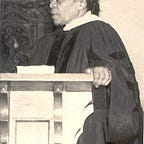The Alice Freeman Palmer Building, 100 Years Later
On the afternoon of Friday, April 7th in 1922 members of the Palmer Memorial Institute community gathered on campus to dedicate the newly constructed Alice Freeman Palmer Building. The program included an opportunity to meet the board of trustees, a walkthrough inspection of the new building, and a tour of the grounds. A student parade also welcomed visitors and was followed by student performances and speeches from leaders in Black education like Dr. James E. Shepard (founder of what is now North Carolina Central University).
In a Greensboro Daily News article published the next day the author remarks that “The dedicatory exercises yesterday were the most largely attended and most enjoyable ever held at the institution.” (Greensboro Daily News, April 8, 1922) The husband of the late Alice Freeman Palmer, for who the school and the building were named, was also in attendance and gave a speech a few days later at the twentieth anniversary ceremony.
After opening, the Alice Freeman Palmer building became the heart of campus. A three-story brick marvel designed by Winston-Salem architect C. Gilbert Humphreys, the building was the first brick structure on campus and the first building in Sedalia to have electricity and plumbing. Over 225,000 bricks were used in the construction of the building, and all were handmade on campus by students.
For students, the AFP building was a hub of activities. The first-floor featured science classrooms and laboratories, music rooms, and culinary classrooms. On the second floor was the Wellesley Auditorium with 230-seats, where donor had been encouraged to purchase a seat to have named after themselves. On the third floor was the school library and the first art collection held by a Black school in the South.
A typical day started with chapel in the auditorium, students moved through the building for the majority of their classes, and even student extracurricular organizations met in spaces like the library. Traditional campus events like graduation, annual concerts, and the annual candlelight Christmas service were all held in the Wellesley Auditorium.
The opening ceremony for the building marked the beginning of a new era for the grounds of the Palmer Memorial Institute. All buildings built after 1922 echoed its grand brick style, fulfilling Dr. Brown’s wish to make Palmer “a little bit of New England in North Carolina.”
Although the building burned down in 1971, some of the original brick foundation is still visible on the site along with a portion of one column.
